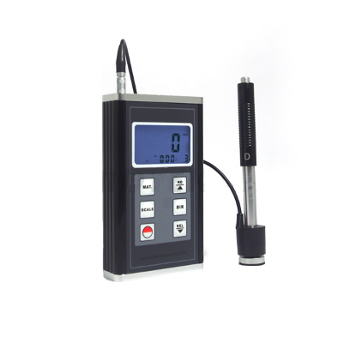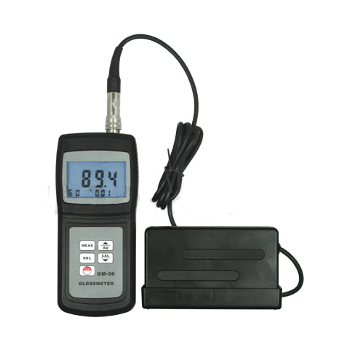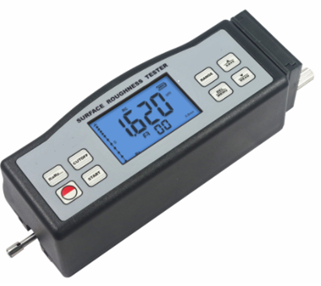Description
Overview
The GAOTek Leeb Hardness Tester with Low Battery Indication (Large Memory) is designed to measure the hardness of metal workpiece and can display the hardness scales of HRB, HRC, HV, HB, HS and HL. It can test at any angle and is applicable to die cavity of molds, inspection of bearing and other mass produced parts on a production line. This hardness tester has large memory and can be stored 50 groups including single measured value, impact direction, material and hardness scale etc. It provides USB Interface to communicate between the tester and the PC. It offers the Blue tooth as the data output.
Key Features
- Portable and Palm size makes it convenient to use.
- Tests at any angle; even upside down.
- Direct display of hardness scales: HRB, HRC, HV, HB, HS and HL.
- Can test a variety of materials including 9 different common materials (Steel and Cast Steel, C. W. Tool Steel, Stainless Steel, Gray Cast Iron, Nodular Cast Iron, Cast Aluminium, Brass, Bronze, Copper)
- Large memory could store 50 groups including single measured value, impact direction, material and hardness scale etc.
- Allows user recalibration function.
- Manual or automatic shutdown.
- Low battery indication.
- LCD Display with Backlight.
- Uses USB data output to connect with PC.
- Provides Bluetooth data output choice.
- Can communicate with PC computer for statistics and printing.
Technical Specifications
| Measuring Range | 170 ~ 960 HLD |
| Accuracy | Display error ± 0.8 % at LD=900 |
| Repeatability | ± 0.6 % |
| Conversion | HL-HRC-HRB-HB-HV-HSD |
| Memory | Storage: 50 data groups (readable) |
| Impact Device | Probe D |
| Impact Device Weight | 0.16 lbs (75 g) |
| Power Supply | 2 x 1.5 V AA (um-3) size battery |
| Dimension | 5.11 in × 2.99 in × 1.25 in (130 mm ×76 mm ×32mm) |
| Weight | 0.74 lbs (340 g not including batteries) |
| Relative Humidity | ≤ 90 % |
| Working Temperature | 32 °F ~ 104 °F (0 °C ~ 40 °C) |
| Storage Temperature | -22 °F ~ 140 °F (-30 °C ~ 60 °C) |
Additional Information
Standard Accessories
- Main Unit
- Standard Test Block
- Measurement Sensor
- Carrying Case
- Operation Manual
- Small Support Ring
- Cleaning brush
Optional Accessories:
- Impact Body
- Support Rings set
- USB data cable with software
- Bluetooth data output with software
Applications and Measurements
Typical Applications
- Die cavity of moulds.
- Inspection of bearing and other mass produced parts on a production line.
- Failure analysis of pressure vessel, steam generator and other equipment.
- Inspection of installed machinery, permanent parts of assembled systems and heavy work pieces.
- Testing surface of a small hollow space.
- Material identification in the warehouse of metallic materials.
- Rapid testing in large range and multi-measuring areas for large-scale work piece.
Measuring and Converting Ranges
| Material | HL | HRC | HRB | HB | HS | HV | |
| 30D2 | 10D2 | ||||||
| Steel & Cast St. | 300 ~ 900 | 20.0 ~ 68.0 | 38.4 ~ 99.5 | 80 ~ 647 | 32.5 ~ 99.5 | 80 ~ 940 | |
| C.W. Tool Steel | 300 ~ 840 | 20.4 ~ 67.1 | 80 ~ 898 | ||||
| ST.STEEL | 300 ~ 800 | 19.6 ~ 62.4 | 46 .5 ~ 101.7 | 85 ~ 655 | 80 ~ 802 | ||
| Gray Cast Iron | 360 ~ 650 | 93 ~ 334 | |||||
| Nodular Cast Iron | 400 ~ 660 | 131 ~ 387 | |||||
| Cast Aluminium | 174 ~ 560 | 20 ~ 159 | |||||
| Brass | 200 ~ 550 | 13.5 ~ 95.3 | 40 ~ 173 | ||||
| Bronze | 300 ~ 700 | 60 ~ 290 | |||||
| Copper | 200 ~ 690 | 45 ~ 315 | |||||
STRUCTURE FEATURE &TESING PRINCIPLE
Structure Feature

Leeb Hardness Testing Principle
An impact body with a spherical test tip made of tungsten carbide is propelled against the sample surface by a spring force and then rebounds back. At a distance of 0.039 in (1 mm) from the sample surface, the impact and rebound velocity of the impact body are measured by the following method: A permanent magnet embedded in the impact body, when passing through the coil in its coil holder, induces in the coil an electric voltage proportional to the velocities of the magnet. Leeb hardness is expressed by the following formula:
HL=1000 × (VB/VA)
Where: HL is Leeb Hardness
VB is the rebound velocity of the impact body
VA is the impact velocity of the impact body
The voltage characteristic of output signal, when the impact body passes through the induction coil is illustrated in the following figure:

Voltage Characteristic of output signal
A Leeb’s Hardness Tester measures the hardness of sample material in terms of Hardness Leeb (HL), which can be converted into other Hardness units (Rockwell B and C, Vicker, Brinell and Shore D). When measuring the hardness of a sample material using the traditional static hardness testing method, a change of applied pressure will result in a change in the hardness reading. This will also happen during a Leeb’s Hardness test when you change the impact device. In measuring the hardness of the same test sample with different impact devices, the Leeb’s hardness values obtained will vary.
Symbols and illustrations of hardness scale
| Symbols | Illustrations |
| LD | Leeb hardness value used with impact device D |
| HB | Brinell hardness value |
| HRB | Rockwell B hardness value |
| HRC | Rockwell C hardness value |
| HSD | Shore hardness value |
| HV | Vicker hardness value |
Symbols of materials
| Symbols | Illustrations |
| 1 | Steel and cast steel |
| 2 | Cold work tool steel |
| 3 | Stainless steel and high temperature-resistant steel |
| 4 | Cast iron with lamellar graphite (grey cast iron GG) |
| 5 | Cast iron with spheroidal and nodular graphite (GGG) |
| 6 | Cast aluminium alloys |
| 7 | Copper – zinc alloys (brass) |
| 8 | Copper-alu /copper-tin alloys (bronze) |
| 9 | Copper |
PREPARATION
Selection of the workpiece to be tested and preparation of its surface prior to testing will help insure accuracy. Magnetism of the sample itself should be avoided. The surface temperature of sample should be less than 248 °F (120 °C).
Weight Requirement
To achieve correct test results, select thick, heavy, and solid work pieces for testing whenever possible. The surface area where the impact body strikes should have an even hardness. A solid workpiece that weighs more than 11 lbs (5 Kg) can be tested on directly with the hardness testers. Support is not necessary for heavy sample. A workpiece that weighs 6 to 11 lbs. (3 to 5 Kg) should be fixed to a bearing or support weighing over 11 lbs (5 kg) to avoid bending, deformation and displacement during testing. A workpiece that weighs less than 4 lbs. (2 Kg) should be secured to a workbench or a stable support. The surface between the workpiece and the support must be hard, clean, and smooth. To secure the workpiece, apply petroleum jelly or yellow grease to the adjoining surfaces of the workpiece and support, press the workpiece firmly onto the support, and eliminate any air between the two surfaces by moving the workpiece back and forth. Proper coupling requires a little experience. Insufficiently coupled samples produce large variations of individual measurements, HL-values which are too low and the operation is characterized by a rattling noise upon impact of the test tip. For the coupling operation, the following prerequisites must be fulfilled:
- The contact surface of the sample and the surface of the base plate must be flat, plane parallel and ground.
- The direction of the test impact must be perpendicular to the coupled surface.
- Minimum thickness of the sample for coupling (0.11 in (3 mm)).
Roughness Requirement
To eliminate measurement errors which could result from the roughness of the test surface, the surface should be polished so that a metallic lustre appears. The roughness (Ra) of the surface must be limited to ≤2 um. Note that the rougher the surface of the workpiece, the lower the hardness test results.
Cleanliness Requirements
To ensure test accuracy, the test surface of the workpiece must be clean and free of any oil stains, rust, and remains from electro-plating or paint.
Stability Requirements
To avoid displacement during testing, the workpiece should be firmly fixed with its test surface perpendicular to the impact direction. Due to the impact of the Impact Body, the test area may deform or vibrate, even for some workpieces with suitable weight and thickness. The tested hardness may be lower than normal. This is especially true for workpieces such as a large plate, along bar or a rod, and workpieces with a curved surface. Some testing recommendations for these workpieces are shown in figure

Samples with Curved Surfaces
The larger the curvature of the workpiece’s surface, the easier the testing operation. Under normal conditions, testing can be done directly with the standard support ring to a curvature with radius of 1.18 in (30 mm) or longer. For a workpiece with a radius of less than 1.18 in (30 mm), a special support ring should be used for testing.

For impact device type D , R min = 1.18 in (30mm)
Test Sample properties
| Sample | Sample Weight (kg) | Min. Thickness (mm) | Max. Roughness (or Min. Fineness) | ||||||
| Impact Device | Needs Support | Needs to be stabilized | No Strengthening needed | Sample | Hardened Layer | ISO | Ra | Rz | |
| D | 0.05 – 2 | 2.5 | >5 | 3 | 0.8 | N7 | 2 µm | 10 µm | Δ 6 |
OPERATION OF THE TESTER
Power on/off
- Press the POWER key, now power is on. The instrument is in working mode.
- The LCD will display the same settings that were previously set. If the display meets your current testing requirements, you can start the test immediately. If not, you can enter your required settings using the keypad.
- The tester can be turned off by pressing the POWER key for 3 seconds while OFF shows on the display.
Setting Your Impact Direction
Use the DIR button to move the cursor until you reach the desired direction.
Press DIR key and release it
![]()
Selecting a Material
Press the MAT key first and release it until the desired material is reached.
Choosing a Hardness Scale
Press the SCALE key first and release it until the desired hardness scale is reached.
Press SCALE key and release it

Average Times Setting
After pressing “Power Key” for 6 seconds into item AVE, press “RD/ ▲key” or “DEL/▼ key” in turn to select the average times from 2-9, selecting 0 means no mean values. Press “Power key” finally to exit from the operation
This function allows you to view the average of the amount of tests you entered.
Example: If you chose “3”. The tester will show the average after 3 consecutive tests
Measuring Procedure
Use standard test block to check your hardness tester prior to a hardness test.
- Loading
Push the Loading Tube towards the support ring to lock the impact body. Then, while s till holding on to the loading tube, slowly return it to its original position.
Caution: Returning the Loading Tube back to its original position too quickly may damage the tester’s parts. Always hold onto the Loading Tube and slowly guide it back in a controlled fashion.

Fig
- Placement
Hold the tester against the Work piece.
Please note: the impact device must be firmly against the surface and the impact direction should be vertical to the testing surface or you may get unsatisfied value.
- Releasing
Press the release button lightly on top of the tester and take measurement. The measuring value will be displayed on LCD. To be sure that while releasing the triggering button, the work piece, the impact device and the impact body are all stable and the starting force coincides with the axis of the impact device.

If the test results are outside the ranges listed in Table, the screen will display E.
Note: Should not press the release button if the tester was not against the work piece. Otherwise the support ring would be loose easily. Each measure area of the sample usually needs 3 to 5 times of testing operation. The result data dispersion should not more than mean value ±15 HL. The distance between any two impact points or from the center of any impact point to the edge of testing sample should conform to the regulation of table.
| Type of Impact Device | Distance of two centre of the two indentations | Distance of centre of the indentation to a sample edge |
| Not less than in (mm) | Not less than in (mm) | |
| D | 0.11 (3) | 0.2 (5) |
Memory Recall
Under measuring mode marked by “M” on the display, press RD/▲ key to enter into mode of viewing stored values marked by “R”. Press RD/▲ key or DEL/ ▼key to recall stored values forwards and backwards. To return to the measurement state, just press the POWER/MENU key.
Delete data in memory
In the measurement state marked by “M” on the display, the new reading can be deleted by pressing DEL/▼ key, and the number of stored reading is accordingly decreased by 1. To clear memory, just press and hold DEL/ ▼key for 3 seconds till the number of stored reading becomes 000.
Download to PC
This tester can communicate with a PC by optional USB or RS-232 cable and software. All the memorized data can download to your PC every time when in a measurement state, you press RD/ ▲key to enter the viewing memorized state.
Auto Power Off
The instrument features an auto power off function designed to conserve battery life. If the tool is idle (neither measuring nor any key operation) for 3 minutes, it will turn itself off.
Battery Replacement
When the battery symbol appears on the display, it is time to replace the batteries. Slide the Battery Cover away from the instrument and remove the batteries. Install batteries paying careful attention to polarity.
CALIBRATION
After a long period of use, especially for measuring harder materials, the ball tip of impact body will be worn which may lead the tester have more or less error on accuracy. At this moment, this tester is designed to allow recalibration. The calibration can be made in the following way.
- Pressing POWER/MENU key for 8 seconds into item CAL, the tester is now in the calibration mode.
- Take measurements on the standard test block.
- Use “RD/ ▲key” or “DEL/▼ key”to adjust the reading of the display to the standard value.
- Repeat 2 till the measurement readings are accurate.
- Press POWER/MENU key to quit from the calibration mode and return to the measurement mode.
Please note: If the measurement error comes within the range of accuracy specification, please do not make calibration easily.
MAINTENANCE & SERVICING
- After the impact device has been used for 1000 ~ 2000 times, please use the nylon brush provided to clean the guide tube and impact body. When cleaning the guide tube, unscrew the support ring first, then take out the impact body, spiral the nylon brush in counter-clock direction into the bottom of guide tube and take it out for 5 times, and then install the impact body and support ring again.
- Release the impact body after use.
- Any lubricant is absolutely prohibited inside the impact device.
- When results from repeated testing on a standard hardness test block are consistently higher than the actual hardness value, the Impact Body is probably worn. In such a case, it is necessary to replace an impact body.



